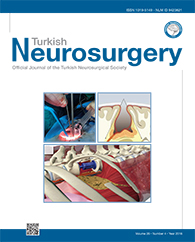2Ankara University, Faculty of Medicine, Department of Histology-Embryology, Ankara, Turkey
3Uludag University, Faculty of Medicine, Department of Neurology, Bursa, Turkey
4Uludag University, Faculty of Medicine, Department of Biostatistics, Bursa, Turkey
5Ankara University, Faculty of Medicine, Department of Neurosurgery, Ankara, Turkey DOI : 10.5137/1019-5149.JTN.14518-15.3 AIM: To demonstrate the effect of glatiramer acetate (GA) in chick embryos on neural tube (NT) development, and to explore its effects of Foxp1, apoptosis, and N-cadherin.
MATERIAL and METHODS: One hundred fertile, specific pathogen free eggs were divided into 5 groups for this study. The eggshell was windowed specifically at 24 hours of incubation. The embryos in Group 1 (n=20) were treated with 10 μl physiological saline; in Group 2 the embryos (n=20) were given 10 μl GA (equal to daily human therapeutic dose); 20 μl GA (equal to twice daily human therapeutic dose) was injected to embryos in Group 3 (n=20); in Group 4 and 5, 30 μl and 40 μl GA were administered to the embryos (n=20) (equal to x3 and x4 daily human therapeutic dose, respectively). Each egg was re-incubated for 24 hours more. Then, histological and immunohistochemical evaluation of the subjects were done.
RESULTS: The embryos with NT defect showed FOXP1 expression without N- cadherin or staining with N-cadherin in another location in our study. We interpreted this result as GA leading to an NT closure defect by increasing FOXP expression. Moreover, we also showed the reverse relation between FOXP1 and N-cadherin at the immunohistochemical level for the first time.
CONCLUSION: GA affects the spinal cord development through FOXP in the chick embryo model at high doses.
Keywords : Chick embryo, Glatiramer acetate, FOXP, N-Cadherin, Spinal cord development




